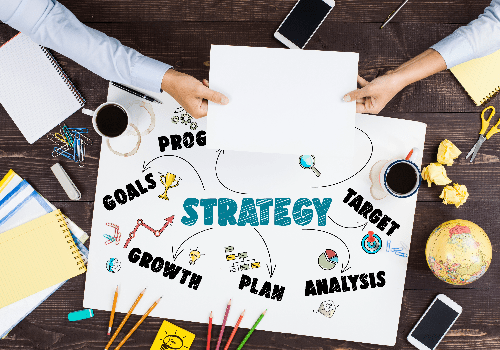The secret to thriving in today’s competitive landscape lies in setting clear, well-defined strategic goals. By understanding the importance of strategic goals, you can focus your organization’s efforts on achieving financial growth, enhancing customer satisfaction, and fostering innovation. In this blog post, we’ll delve into 21 strategic goal example scenarios that can help you navigate the path to success.
Key Takeaways
Understanding and setting strategic goals is essential for long-term success.
Strategic goals should focus on financial, customer, growth and internal objectives.
Prioritizing goals based on impact/feasibility. Monitoring progress & adapting to change are key components of achieving them successfully.
Understanding Strategic Goals

Your organization’s success hinges on strategic goals. Providing direction, focus, and a decision-making framework, they ensure alignment with your business’s mission and vision. Some examples of strategic goals include:
Achieving financial objectives
Improving customer satisfaction
Increasing market share
Enhancing employee engagement and productivity
Expanding into new markets
Developing innovative products or services
These strategic goals encompass a wide range of areas that contribute to your company’s long-term success, each representing a strategic goal or strategic objective within the overall strategic plan, which is driven by your strategic planning goals.
The Role of Strategic Goals in Business Success
Behind your organization’s decision-making, resource allocation, and operational execution, strategic goals serve as the guiding force. Providing a clear path towards long-term success, they ensure alignment of your company’s actions with its vision and mission. Moreover, strategic goals help to create a cohesive organizational strategy, uniting teams and individuals under a shared purpose.
A successful organizational strategy should encompass various aspects of the business, including:
Financial performance
Customer satisfaction
Growth
Business processes
By setting strategic goals that address these areas, you can create a well-rounded approach that drives your business forward. The Balanced Scorecard is one such framework that can help guide your strategic objectives, ensuring a comprehensive and aligned strategy.
Key Components of Effective Strategic Goals

Truly effective strategic goals must be:
Purpose-driven
Long-term
Actionable
Measurable
This means that each goal should be directly tied to your organization’s mission and vision, have a clear focus on the desired outcome, and include a plan for achieving it. Additionally, setting measurable targets allows you to monitor progress and determine whether your goals are being met or if adjustments need to be made.
Examples of Financial Strategic Goals

Geared towards improving your company’s financial performance, financial strategic goals focus on increasing revenue, reducing costs, and boosting profitability. Setting financial strategic goals allows your organization to allocate resources better, streamline operations, and achieve success.
In the following sections, we’ll explore examples of financial strategic goals in more detail. This HBR article also gets into financial goals and strategic consequences.
Increasing Revenue
Expanding market share, launching new products, or improving customer retention are fundamental ways to increase revenue. Targeting new customer segments, offering innovative products and services, and ensuring customer satisfaction can generate more sales and financial growth for your company.
Furthermore, investing in marketing campaigns and sales initiatives can also help to attract new customers and increase revenue.
Reducing Costs
Another key aspect of financial strategic goals is cost reduction. This can be achieved by streamlining operations, optimizing resource allocation, and implementing cost-saving measures. For example, a company might prioritize improving efficiency, cutting down on waste, or renegotiating contracts with suppliers in order to reduce costs.
Lowering expenses can boost your organization’s profitability and enhance its overall financial performance.
Boosting Profitability
A delicate balance between increasing revenue and reducing costs is required to boost profitability. Focusing on long-term growth ensures sustainable financial success for your company. This might involve diversifying revenue streams, optimizing pricing strategies, or exploring new markets to expand your customer base.
In addition, fostering a culture of operational excellence and continuous improvement can help to drive profitability and maintain a competitive edge in the market.
Examples of Customer-Focused Strategic Goals

Prioritizing enhancing customer satisfaction, building customer loyalty, and improving customer retention, customer-focused strategic goals are set. These goals are essential for creating long-lasting relationships with your customers and ensuring the long-term success of your business.
Let’s explore some examples, particularly focusing on customer-focused strategic goals and the strategic objective examples that can help you achieve them.
Enhancing Customer Satisfaction
All about understanding your customers’ needs, improving customer satisfaction involves:
Providing high-quality products and services catering to those needs
Investing in customer support
Tailoring experiences to individual preferences
Addressing any issues or concerns promptly and effectively
Delivering exceptional customer service and fostering a culture of continuous improvement can enhance customer satisfaction and drive long-term success for your company.
Building Customer Loyalty
Creating positive experiences, offering incentives, and fostering strong relationships with customers are required to build customer loyalty. This can be achieved through targeted marketing campaigns, personalized offers, and exceptional customer support.
Cultivating loyalty among your customers can lead to repeat business, reduced acquisition costs, and increased profitability for your organization.
Improving Customer Retention
Identifying and addressing the factors that contribute to customer churn, such as product quality, pricing, and customer service, is involved in improving customer retention. To achieve this, your organization should invest in product development, competitive pricing strategies, and exceptional customer support. Focusing on these aspects can minimize customer churn, enhance brand loyalty, and ultimately boost your company’s bottom line.
Examples of Growth-Oriented Strategic Goals

Centered around expanding market share, developing new products, and fostering innovation, growth-oriented strategic goals are set. Setting growth-oriented goals enables your organization to seize new opportunities, achieve long-term success, and maintain a market competitive edge.
In this section, we’ll explore some examples of growth-oriented goals in more detail.
Expanding Market Share
Through targeted marketing efforts, strategic partnerships, and acquisitions, expanding market share can be achieved. These strategies can help your organization reach new customer segments, enter new markets, and ultimately increase revenue.
Focusing on expanding market share can grow your company’s market presence and enhance its overall performance.
Developing New Products
Investing in research and development, identifying market opportunities, and leveraging existing resources and capabilities are involved in developing new products. Focusing on product development can keep your organization ahead of the curve, meet evolving customer needs, and drive long-term growth.
In addition, a successful product launch can create buzz and interest in your brand, leading to increased sales and market share.
Fostering Innovation
Creating a culture that encourages creativity, collaboration, and risk-taking, along with investing in new technologies and processes are required to foster innovation. Nurturing a culture of innovation can drive continuous improvement, develop groundbreaking products and services, and maintain a competitive edge in the market for your organization.
Moreover, fostering innovation can help your organization stay agile and adapt to changes in the business environment, ensuring long-term success.
Examples of Internal Strategic Goals

Aiming to improve employee satisfaction, strengthen organizational culture, and build a strong workforce, internal strategic goals are set. Focusing on these internal aspects can help your organization create a positive work environment that promotes collaboration, innovation, and overall success.
In the following sections, we’ll delve into examples of internal strategic goals and how they can benefit your company.
Improving Employee Satisfaction
Offering competitive compensation and benefits, providing growth and development opportunities, and fostering a positive work environment are involved in improving employee satisfaction. Investing in employee satisfaction can not only reduce employee turnover but also create a more engaged and productive workforce for your organization.
In addition, a satisfied workforce is more likely to deliver exceptional customer service, contribute to innovation, and drive long-term success.
Strengthening Organizational Culture
Promoting shared values, open communication, and team member collaboration are required to strengthen organizational culture. Cultivating a strong organizational culture can foster trust, encourage teamwork, and promote innovative practices in your company.
In turn, a strong organizational culture can contribute to employee satisfaction, improved productivity, and long-term success.
Building a Strong Workforce
Attracting and retaining top talent, investing in employee development, and implementing effective performance management systems are involved in building a strong workforce. A strong workforce can increase your organization’s competitiveness, enhance efficiency and productivity, and improve customer satisfaction.
Focusing on developing a capable workforce can help your company achieve long-term success and maintain a competitive edge in the market.
Setting and Achieving Your Strategic Goals

Involving prioritization of goals based on alignment with the company’s mission and vision, progress monitoring, and adaptation to business environment changes, setting and achieving strategic goals is done through the strategic planning process. By following a systematic approach to strategic planning, your organization can stay on track, make informed decisions, and ensure long-term success.
Prioritizing Goals
Evaluating the potential impact, feasibility, and alignment with the company’s overall strategy and resources is important to prioritize your strategic goals. Factors such as cost-benefit analysis, resource availability, and risk assessment can help you determine which goals should take precedence. Prioritizing your goals based on these criteria can ensure your organization remains focused on the most critical objectives and effectively allocates resources.
Monitoring Progress
Involving tracking of key performance indicators (KPIs) and necessary plan and action adjustments to stay on track, monitoring progress towards your strategic goals is done. Regularly reviewing your KPIs and making necessary adjustments can help your organization maintain focus, adapt to changes in the business environment, and ensure the successful achievement of your goals.
Adapting to Change
Being proactive, regularly reviewing and updating your strategic goals, and maintaining a focus on long-term success are required to adapt to change in the business environment. By staying abreast of industry developments and adjusting your goals as needed, you can ensure that your organization remains agile, resilient, and well-prepared for future challenges and opportunities.
Summary
In conclusion, setting strategic goals is crucial for driving long-term success and providing direction for your organization. By focusing on financial, customer-focused, growth-oriented, and internal strategic goals, you can create a well-rounded approach that propels your business forward. Remember to prioritize your goals, monitor progress, and adapt to change to ensure the successful achievement of your objectives. With a clear vision and a commitment to continuous improvement, your organization can thrive in today’s competitive landscape.
Frequently Asked Questions
What is an example of goal strategy?
An example of goal strategy is setting a deadline for achieving specific goals, such as entering new markets or achieving 15 regional markets by a certain date. This provides clarity and focus to help make the goal achievable.
Which is a strategic goal?
A strategic goal is an objective that an organization sets to achieve a long-term plan. Examples of strategic goals include increasing revenue, improving customer satisfaction, expanding market share, reducing costs and enhancing operational efficiency.
What are the key components of effective strategic goals?
Effective strategic goals should be purpose-driven, long-term, actionable, and measurable, with a focus on the desired outcome and a plan for achieving it.


